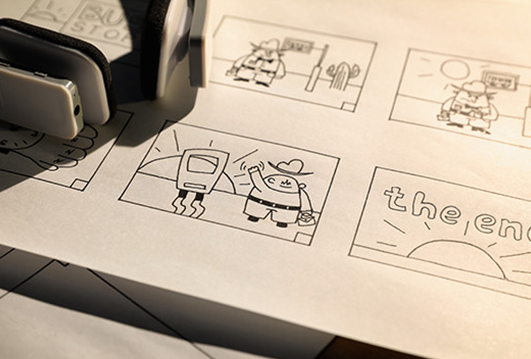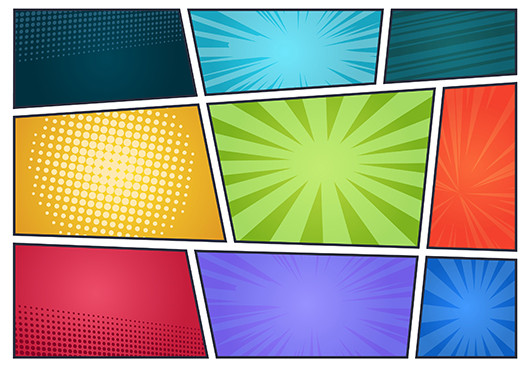Create a Comic: How to Plan and Lay Out Your Comic
August 2, 2022
The comic book industry is a billion-dollar business. Comic books are a unique and engaging medium that can tell stories in ways other forms of storytelling cannot. Whether you’ve been a comics enthusiast for a long time or are an aspiring artist just getting into the medium, you may have considered creating your own comics.
While this is no easy feat, it can be gratifying, especially if you have the drive to make your publications a success. The general comic planning process requires brainstorming, outlining, scripting, and layouts. You’ll encounter challenges even if you’re writing a story with minimal worldbuilding and simple character designs.
Readers can find inconsistencies or plot holes quickly, and scenes that make sense to you might not make sense to your readers if you haven’t planned out the visuals carefully. Learn some essential steps in comic book creation to equip yourself with the information you need to develop professional-grade material.
Brainstorm Comic Ideas
Brainstorming ideas for a comic book can be daunting, especially if you’re starting from scratch. However, there are a few key elements that all good comic books share. First, you need a strong storyline. This is the foundation of your comic book and will determine everything from the characters to the setting.
Once you have a storyline, you can start thinking about the individual scenes and panels. What will your readers see on each page? How will the story unfold? Next, you need to think about the comic book project itself. Who are your ideal comic book artists? What kind of style do you want your book to have? It's important to remember that your book should reflect your personal connection to the story. Putting some of your personality on the pages helps the story become more engaging and relatable to your readers.
Write the Story
Writing the story first is the most important part of comic book creation. Without a strong plot, the comic will lack direction and fail to engage readers. The story should have a clear beginning, middle, and end, with well-defined characters and conflict.
Once the story is complete, the comic book artist can bring it to life with pencils, inks, and colors. The finished book will be a work of art that will entertain and inspire readers of all ages.
Convert the Story to a Storyboard
A storyboard is a critical part of any comic book project. It allows you to plan out your story, decide on panel layouts, and figure out the flow of your story. The most important thing to remember when creating a storyboard is that it should be clear and easy to read.
Having your story already written makes the storyboard section much easier. Comic builder software can be a great way to create a storyboard, as it provides a wide range of templates and tools to help you get started.
Rough drafts of comic strips can also be a helpful way to plan out your storyboard, as they provide a basic structure you can work with. No matter what method you use, make sure your storyboard is clear and concise to plan out your comic book project efficiently.
Plan the Layout
Comic books are a type of visual storytelling that combines both images and words to create engaging stories. When creating a comic book layout, there are several factors to keep in mind, such as the placement of panels, speech bubbles, and the story’s overall flow. Following these basic guidelines, you can create unique comic strips that capture your readers’ attention.
It is crucial to consider the placement of panels. The panel is the basic comic unit, typically containing a single image or scene. When laying out panels, creating a balance between empty space and content is essential.
Too much space can make a strip seem unengaging, while too much content can overwhelm readers. It is also essential to consider how panels will be arranged on the page. In most cases, panels are arranged grid-like, but varying the arrangement can add interest and visual appeal.
Speech bubbles are an essential part of any comic strip. They help convey dialog and thoughts and can also be used to add humor or other emotions. When placing speech bubbles, keeping them legible and easy to read is vital. Be careful not to overcrowd the page with unnecessary dialog.

Select the Right Comic Book Panels
Selecting the right panels carefully to create a great comic book is crucial. Each panel should advance the story while also providing visual interest. One way to create visual interest is to use a wide variety of panel sizes and shapes. Another way to add interest is to use a variety of perspectives, including close-ups and wide shots.
It is often effective to use a mixture of dialog and narration to keep the reader engaged. Comics are also known for their sound effects, which are created using various methods, including onomatopoeia, alliteration, and rhythm. When selecting panels for a comic book, it is vital to keep these elements in mind to create an engaging and visually interesting story.
Many beginner comic book artists have trouble knowing how to select the right comic book panels. There are a few factors that you need to take into account when making your decision. You need to consider the break between panels, also called the gutter. You want to ensure enough of a break so the reader can understand that a new scene is taking place.
You also need to create a dialog for the actual bubble. Make sure the bubble is big enough so the reader can understand what is being said. However, it's also important not to overload the page with text. You may need to experiment with several options before deciding on a final comic book layout.
Develop Visual Consistency
Visual consistency is one of the most important aspects of a great comic book. Every comic page should contain illustrations, imagery, and text congruent with the storyline. The illustrations must be high quality and provide readers with an immersive experience. In addition, illustrations should be appropriate for the target audience.
For example, a children’s comic book would have illustrations vastly different from a more mature comic book. Comic book content needs a consistent visual flow and tone to avoid jarring or alienating the audience.
The finished book should be a polished and professional product that is enjoyable to read. The key aspects of creating a visually consistent comic are:
Drawings and Illustrations
One of the challenges facing a comic book artist is maintaining consistent drawings from panel to panel and page to page. This is especially true if you’re working on a long-running series, where the characters and their world must remain consistent over time.
There are several ways to overcome this challenge. One is to use reference material, such as photos or 3D models to ensure that your drawings are accurate. Another option is to use digital drawing tools, which can help you achieve a consistent look more easily.
However, many comic book artists still prefer the traditional method of hand drawing, as it gives them more control over the final product. Whichever method you choose, it is important to be mindful of consistency when creating your comic book art. Consider hiring a professional artist if illustrations aren't your strong point.
Coloring
Color is an essential visualization tool for your comic book series. It can set the mood of a scene, create contrast, and evoke emotions in the reader. A consistent color palette is critical for artists throughout a finished book. Additional images, such as black-and-white line art or color sketches, can contribute to the theme or mood.
However, it is ultimately up to the artist and colorist to collaborate to ensure that the colors used in a book work well together and create the desired effect. Amateur comic creators often overlook color schemes since it seems like a straightforward part of the design process.
Carefully selecting and using a distinct palette adds a layer of depth and richness to a comic book storyline. Hiring a professional colorist to assist with this plan aspect can be beneficial.
Lettering
Lettering a comic book is an art form in itself. From font selection to creating impactful text, the letterer is responsible for curating a reading experience that is enjoyable and easy to follow. While several software programs can be used for comic book lettering, many professional letterers still prefer to do it by hand.
Comic strip templates are a great way to get started, providing a standard format for each panel. You can experiment with different types and formats to find a lettering style that best fits your visual layout and conveys your message properly.
Get Your Comic Book Print Ready
Once you’ve decided on every break between panels, created the layout of your virtual content, and finalized the plan for your comic, it’s time to put the pieces together. All the prep work may seem overwhelming, but in the end, it will make your finished product more polished. Avoiding inconsistencies in the story or unclear details in your art is vital to the reader's experience.
Perfecting Your Comic Book
If you’re struggling with the technical aspects of laying out your comic book pages, the team at Comix Well Spring can help. We provide free printing templates to artists, ensuring that the final printed comic matches your created layout and design.
Our experienced and friendly staff will happily answer your questions about the appropriate size and formatting for your work. Since we specialize in comic printing, we know the challenges artists face and offer guidance so your finished product turns out as you imagined.
Once your virtual content is print-ready, we will provide you with professional-grade publications. Depending on your preferences and budget, you can choose from various sizes, paper styles, cover finishes, stitching types, and more. Before signing off on your prints, we encourage you to check the final proofs for possible errors or corrections.
Finalizing Your Order
We have a 25-copy minimum on print runs, making us a budget-friendly option for creators just starting out. Our 14-day standard production turnaround helps you meet your deadlines and keep your readers happy. If you require a speedier delivery, our lightning-fast option allows you to receive your order in just 2 to 6 days.
Bring Your Comic to Life With Comix Well Spring
For more information on our printing services, contact Comix Well Spring today. Check out our blog to learn more about comic book creation and other tips like how to write a graphic novel and how to publish a comic book if you can’t draw.

